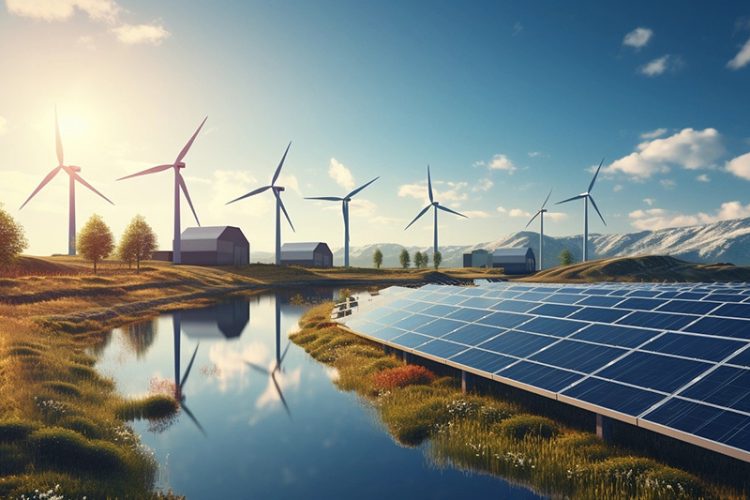Introduction: A New Era for the Energy Sector
Over the past decade, the new energy sector, encompassing renewable energy sources such as solar, wind, hydropower, and electric vehicles (EVs), has undergone significant growth. Driven by global concerns over climate change, sustainability, and the need to reduce carbon emissions, the push for cleaner, greener energy solutions has never been stronger. At the same time, technological innovations, policy support, and shifting consumer demand are reshaping the landscape, potentially ushering the industry into what some are calling its “golden age.”
In this article, we’ll explore whether the new energy industry is indeed entering a golden age, analyzing the latest market trends, technological advancements, and government policies that are driving growth. We’ll also look at the investment opportunities emerging from this transformation and how investors can position themselves to take advantage of this rapidly evolving sector.
Chapter 1: The Accelerating Shift Toward Renewable Energy
1.1 A Global Push for Clean Energy
One of the defining characteristics of the energy transition over the past decade has been the accelerating global push toward renewable energy. Countries across the world, especially those in the European Union, China, and the United States, have set ambitious targets to reduce carbon emissions and increase the share of renewables in their energy mix. This shift is driven by a combination of factors:
- Climate Change Action: With the growing urgency to combat climate change, nations have been implementing stricter environmental regulations. The Paris Agreement (2015) set a global framework for limiting global warming to below 2°C, with many countries now setting net-zero emission goals by 2050.
- Technological Advancements: Renewable energy technologies like solar panels, wind turbines, and battery storage have become more efficient, reliable, and cost-effective. This has made them increasingly competitive with traditional fossil fuels.
- Consumer Demand: There is rising consumer and corporate demand for clean energy. Businesses are committing to sustainability goals, while consumers are choosing eco-friendly products and services.
1.2 Market Dynamics in Renewable Energy
The renewable energy sector has seen significant expansion in recent years. Here are the key market trends that suggest we may be entering a golden age:
- Solar and Wind Energy: The global renewable energy capacity reached 3,000 GW in 2021, with solar and wind making up the largest share. According to the International Renewable Energy Agency (IRENA), solar energy has grown by 20% annually, and wind energy is on track to increase at a similar rate.
- Battery Storage and Grid Modernization: As solar and wind become a more significant part of the global energy mix, energy storage technologies (particularly lithium-ion batteries) are becoming essential to ensure grid stability and manage intermittency.
- Electric Vehicles (EVs): The EV market has skyrocketed in recent years, driven by advances in battery technology, lower prices, and government incentives. In 2021, global EV sales exceeded 6.6 million units, a 108% increase from the previous year, signaling a shift in how we think about transportation and energy consumption.
Chapter 2: Technological Innovations and Their Role in Growth
2.1 Next-Generation Energy Storage
One of the major challenges of renewable energy—especially solar and wind—is their intermittency: the sun doesn’t always shine, and the wind doesn’t always blow. Energy storage technologies, particularly lithium-ion batteries, are crucial to solving this problem by storing energy for use when production from renewable sources is low.
In recent years, we have seen significant advances in energy storage technologies that could revolutionize the energy sector:
- Solid-State Batteries: These next-generation batteries are expected to be safer, longer-lasting, and more efficient than current lithium-ion batteries. Companies like QuantumScape are leading the charge in this area.
- Grid-Scale Storage: Larger-scale storage solutions, like pumped hydro storage and compressed air energy storage (CAES), are gaining traction for storing excess energy on the grid.
- Artificial Intelligence (AI) and Smart Grids: AI is enabling utilities to better predict energy demand, optimize energy storage, and create more efficient and reliable smart grids that integrate renewable sources more effectively.
2.2 Advances in Solar and Wind Power Technologies
Technology is also driving down the cost of solar and wind energy, making them increasingly viable alternatives to fossil fuels.
- Solar Power: The cost of solar energy has dropped significantly over the last decade, with prices falling by as much as 89% for solar panels since 2010. The introduction of bifacial solar panels, which capture sunlight from both sides, and perovskite solar cells, which are cheaper to produce, are expected to further lower costs.
- Offshore Wind: Offshore wind power is one of the fastest-growing sectors in renewables. The development of floating wind turbines has expanded the potential for offshore wind farms to areas with deeper waters, further increasing their viability.
2.3 Hydrogen Economy: A Game Changer
Another exciting development in the new energy sector is the rise of green hydrogen. Hydrogen fuel is seen as a potential clean energy solution, particularly for sectors that are harder to decarbonize, such as heavy industry and long-haul transportation. The process of producing green hydrogen using renewable electricity from solar or wind has received significant attention and investment.
The hydrogen economy is beginning to take shape with large-scale projects across the globe, particularly in Europe and Asia, which are positioning themselves as leaders in hydrogen technology.
Chapter 3: Policy Support and Investment Trends
3.1 Government Incentives and Policies
Government policies and regulations play a significant role in driving the growth of the new energy sector. In the post-pandemic world, many governments have prioritized sustainability and green recovery plans. Key initiatives include:
- U.S. Infrastructure Bill: The American Jobs Plan, signed into law in 2021, includes a massive push for clean energy investment, including $7.5 billion for electric vehicle charging infrastructure and incentives for renewable energy projects.
- EU Green Deal: The European Green Deal aims to make Europe the first climate-neutral continent by 2050. The EU has committed significant funding to renewable energy projects and clean technologies.
- China’s 14th Five-Year Plan: China has set ambitious goals to increase the share of non-fossil fuel energy in its energy mix, aiming for carbon neutrality by 2060. This has spurred investments in solar, wind, and electric vehicles.
3.2 Investment Flow Into Renewable Energy
Investor interest in the new energy sector has also surged. Renewable energy stocks have experienced strong growth, with sectors like solar, wind, and electric vehicles drawing significant capital.
- Renewable Energy ETFs: Exchange-traded funds (ETFs) focusing on renewable energy stocks, like Invesco Solar ETF and iShares Global Clean Energy ETF, have seen a steady rise in popularity among investors.
- Green Bonds: Governments and corporations are increasingly issuing green bonds to fund sustainable projects, with global green bond issuance reaching record highs in recent years.
- Venture Capital and Private Equity: Venture capital is flowing into innovative clean-tech companies. Startups in solar energy, battery storage, and hydrogen have raised billions in funding.

Chapter 4: Challenges and Risks in the New Energy Sector
4.1 Supply Chain Bottlenecks
Despite the positive trends, the new energy sector faces some significant challenges:
- Raw Material Shortages: Many renewable energy technologies, particularly batteries and solar panels, rely on specific raw materials like lithium, cobalt, and nickel. The demand for these materials has surged, and supply chain disruptions have caused price volatility.
- Grid Integration: While renewable energy production is on the rise, the integration of renewable energy sources into national grids is still a complex challenge. The infrastructure required to support this transition is costly and will require significant investment.
4.2 Regulatory Uncertainty
While governments around the world are pushing for green energy, there is still regulatory uncertainty surrounding long-term policies. Changes in tax incentives, subsidies, and trade policies can have a significant impact on the viability of renewable energy projects.
4.3 Competitive Pressures
As the industry grows, competition is increasing. Companies in the renewable energy sector are facing pricing pressures as technologies mature and new players enter the market. Investors must be cautious about identifying the right companies with strong long-term prospects.
Chapter 5: How Can Investors Capitalize on the New Energy Boom?
5.1 Diversify Within the Sector
Investors looking to capitalize on the new energy boom should focus on diversification. There are numerous sub-sectors within the new energy space that are growing, and investing in a broad range of companies can reduce risk.
- Renewable Energy Producers: Companies involved in the production of solar, wind, and hydropower are good long-term plays.
- Energy Storage Providers: Companies developing battery storage technologies, like Tesla and Enphase Energy, are expected to grow as demand for renewable energy increases.
- EV Manufacturers: With the growth of electric vehicles, companies like Tesla, NIO, and Rivian are attracting significant investor interest.
5.2 Invest in Green ETFs and Funds
For those looking to invest in the sector without picking individual stocks, renewable energy ETFs offer a diversified portfolio of companies in the clean energy space. Funds like iShares Global Clean Energy ETF and SPYG Clean Energy Fund offer investors exposure to the industry while mitigating risks.
5.3 Stay Informed and Long-Term Focused
As with any industry, keeping track of the latest market trends, technological developments, and policy shifts is crucial for successful investing in the new energy sector. Investors should remain focused on long-term trends and avoid being swayed by short-term volatility.
Conclusion: The Golden Age of New Energy?
The new energy sector is clearly undergoing a transformation, with rapid technological advancements, growing policy support, and increasing investor interest. While there are challenges, including supply chain disruptions and regulatory risks, the potential for explosive growth in the coming decades is undeniable.
As the world continues to transition towards sustainable energy solutions, the new energy sector could very well be entering its golden age. Investors who position themselves early in the right areas of the sector—whether it’s renewable energy, electric vehicles, energy storage, or green technologies—may stand to benefit from this long-term trend.
The key to success will be research, diversification, and a long-term investment approach.


















































